
A comet is an icy, small Solar System body that, when passing close to the Sun, warms and begins to release gases, a process that is called outgassing. This produces a visible atmosphere or coma, and sometimes also a tail. These phenomena are due to the effects of solar radiation and the solar wind acting upon the nucleus of the comet. Comet nuclei range from a few hundred meters to tens of kilometers across and are composed of loose collections of ice, dust, and small rocky particles. The coma may be up to 15 times Earth's diameter, while the tail may stretch beyond one astronomical unit. If sufficiently bright, a comet may be seen from Earth without the aid of a telescope and may subtend an arc of 30° across the sky. Comets have been observed and recorded since ancient times by many cultures and religions.

2060 Chiron is a small Solar System body in the outer Solar System, orbiting the Sun between Saturn and Uranus. Discovered in 1977 by Charles Kowal, it was the first-identified member of a new class of objects now known as centaurs—bodies orbiting between the asteroid belt and the Kuiper belt.
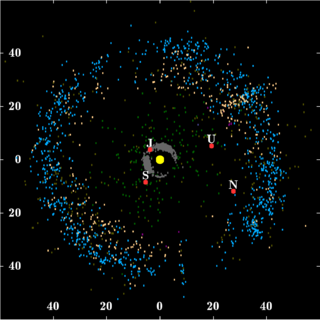
In planetary astronomy, a centaur is a small Solar System body with either a perihelion or a semi-major axis between those of the outer planets. Centaurs generally have unstable orbits because they cross or have crossed the orbits of one or more of the giant planets; almost all their orbits have dynamic lifetimes of only a few million years, but there is one known centaur, 514107 Kaʻepaokaʻawela, which may be in a stable orbit. Centaurs typically exhibit the characteristics of both asteroids and comets. They are named after the mythological centaurs that were a mixture of horse and human. Observational bias toward large objects makes determination of the total centaur population difficult. Estimates for the number of centaurs in the Solar System more than 1 km in diameter range from as low as 44,000 to more than 10,000,000.

1566 Icarus is a large near-Earth object of the Apollo group and the lowest numbered potentially hazardous asteroid. It has is an extremely eccentric orbit (0.83) and measures approximately 1.4 km (0.87 mi) in diameter. In 1968, it became the first asteroid ever observed by radar. Its orbit brings it closer to the Sun than Mercury and further out than the orbit of Mars, which also makes it a Mercury-, Venus-, and Mars-crossing asteroid. This stony asteroid and relatively fast rotator with a period of 2.27 hours was discovered on 27 June 1949, by German astronomer Walter Baade at the Palomar Observatory in California. It was named after the mythological Icarus.

Eleanor Francis "Glo" Helin was an American astronomer. She was principal investigator of the Near-Earth Asteroid Tracking (NEAT) program of NASA's Jet Propulsion Laboratory.

The Spacewatch project is an astronomical survey that specializes in the study of minor planets, including various types of asteroids and comets at Kitt Peak National Observatory near Tucson, Arizona, in the United States.
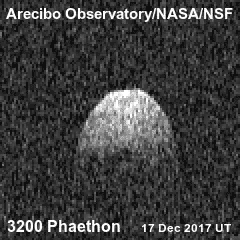
3200 Phaethon, provisional designation 1983 TB, is an active Apollo asteroid with an orbit that brings it closer to the Sun than any other named asteroid. For this reason, it was named after the Greek myth of Phaëthon, son of the sun god Helios. It is 5.8 km (3.6 mi) in diameter and is the parent body of the Geminids meteor shower of mid-December. With an observation arc of 35+ years, it has a very well determined orbit. The 2017 Earth approach distance of about 10 million km was known with an accuracy of ±700 m.
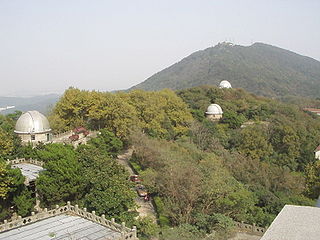
The Purple Mountain Observatory, also known as Zijinshan Astronomical Observatory is an astronomical observatory located on the Purple Mountain in the east of Nanjing.

David Clifford Jewitt is a British-American astronomer who studies the Solar System, especially its minor bodies. He is based at the University of California, Los Angeles, where he is a Member of the Institute for Geophysics and Planetary Physics, the Director of the Institute for Planets and Exoplanets, Professor of Astronomy in the Department of Physics and Astronomy and Professor of Astronomy in the Department of Earth, Planetary and Space Sciences. He is best known for being the first person to discover a body beyond Pluto and Charon in the Kuiper belt.
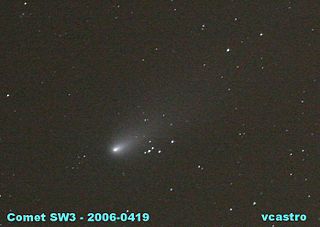
73P/Schwassmann–Wachmann, also known as Schwassmann–Wachmann 3, is a periodic comet in the Solar System that is in the process of disintegrating. Starting the 2011 perihelion passage the primary component 73P-C was recovered on 28 November 2010 near apparent magnitude 21.3; it came to perihelion on 16 October 2011.
118401 LINEAR, provisional designation 1999 RE70, is an asteroid and main-belt comet (176P/LINEAR) that was discovered by the Lincoln Near-Earth Asteroid Research (LINEAR) 1-metre telescopes in Socorro, New Mexico on September 7, 1999. (118401) LINEAR was discovered to be cometary on November 26, 2005, by Henry H. Hsieh and David C. Jewitt as part of the Hawaii Trails project using the Gemini North 8-m telescope on Mauna Kea and was confirmed by the University of Hawaii's 2.2-m (88-in) telescope on December 24–27, 2005, and Gemini on December 29, 2005. Observations using the Spitzer Space Telescope have resulted in an estimate of 4.0±0.4 km for the diameter of (118401) LINEAR.

A minor planet is an astronomical object in direct orbit around the Sun that is neither a planet nor exclusively classified as a comet. Before 2006, the International Astronomical Union (IAU) officially used the term minor planet, but during that year's meeting it reclassified minor planets and comets into dwarf planets and small Solar System bodies (SSSBs).
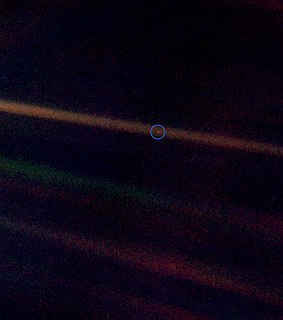
Discovery and exploration of the Solar System is observation, visitation, and increase in knowledge and understanding of Earth's "cosmic neighborhood". This includes the Sun, Earth and the Moon, the major planets Mercury, Venus, Mars, Jupiter, Saturn, Uranus, and Neptune, their satellites, as well as smaller bodies including comets, asteroids, and dust.
The Solar System — our Sun's system of planets, moons, and smaller debris — is humankind's cosmic backyard. Small by factors of millions compared to interstellar distances, the spaces between the planets are daunting, but technologically surmountable.
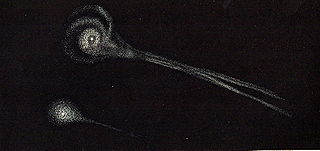
A lost comet is one which was not detected during its most recent perihelion passage. This generally happens when data is insufficient to reliably calculate the comet's location or if the solar elongation is unfavorable near perihelion passage. The D/ designation is used for a periodic comet that no longer exists or is deemed to have disappeared.

An extinct comet is a comet that has expelled most of its volatile ice and has little left to form a tail and coma. In a dormant comet, rather than being depleted, any remaining volatile components have been sealed beneath an inactive surface layer.
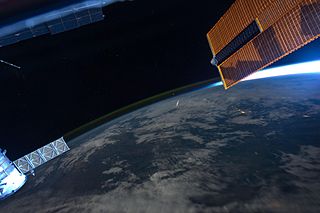
Comet Swift–Tuttle is a large periodic comet with a 1995 (osculating) orbital period of 133 years that is in a 1:11 orbital resonance with Jupiter. It fits the classical definition of a Halley-type comet with an orbital period between 20 and 200 years. The comet was independently discovered by Lewis Swift on July 16, 1862 and by Horace Parnell Tuttle on July 19, 1862.

Comets have been observed for over 2,000 years. During that time, several different systems have been used to assign names to each comet, and as a result many comets have more than one name.

2017 YE5 is a binary pair of asteroids of approximately equal size and mass, each about 0.9 km (0.56 mi) in diameter. Classified as a near-Earth asteroid and potentially hazardous object of the Apollo group, 2017 YE5 was discovered by amateur astronomer Claudine Rinner at the Oukaïmeden Observatory on 21 December 2017. On 21 June 2018, the pair of asteroids passed within 15.5 lunar distances or approximately 6 million km (3.7 million mi) from Earth. During the close encounter, 2017 YE5 was resolved in high detail by concurrent radar observations by the Arecibo and Green Bank observatories, along with individual observations by the Goldstone Solar System Radar. 2017 YE5 is likely an extinct or dormant comet due to its distant elliptical orbit and dark red surface.
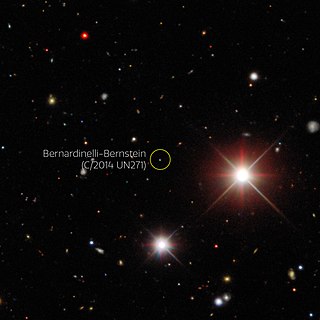
C/2014 UN271 (Bernardinelli-Bernstein), or simply 2014 UN271, or the Bernardinelli–Bernstein comet (nicknamed BB), is a large Oort cloud comet discovered by astronomers Pedro Bernardinelli and Gary Bernstein in archival images from the Dark Energy Survey. When first imaged in October 2014, the object was 29 AU (4.3 billion km) from the Sun, almost as far as Neptune's orbit and the greatest distance at which a comet has been discovered. During 2021, it will approach the Sun from a distance of 20.8 AU (3.1 billion km) to 19.5 AU (2.9 billion km) and will reach its perihelion of 10.9 AU (just outside of Saturn's orbit) in January 2031. The current 3-sigma uncertainty in the comet's distance from the Sun is ±60000 km. It is potentially the largest Oort cloud comet discovered. It will not be visible to the naked eye because it will not enter the inner Solar System.

















